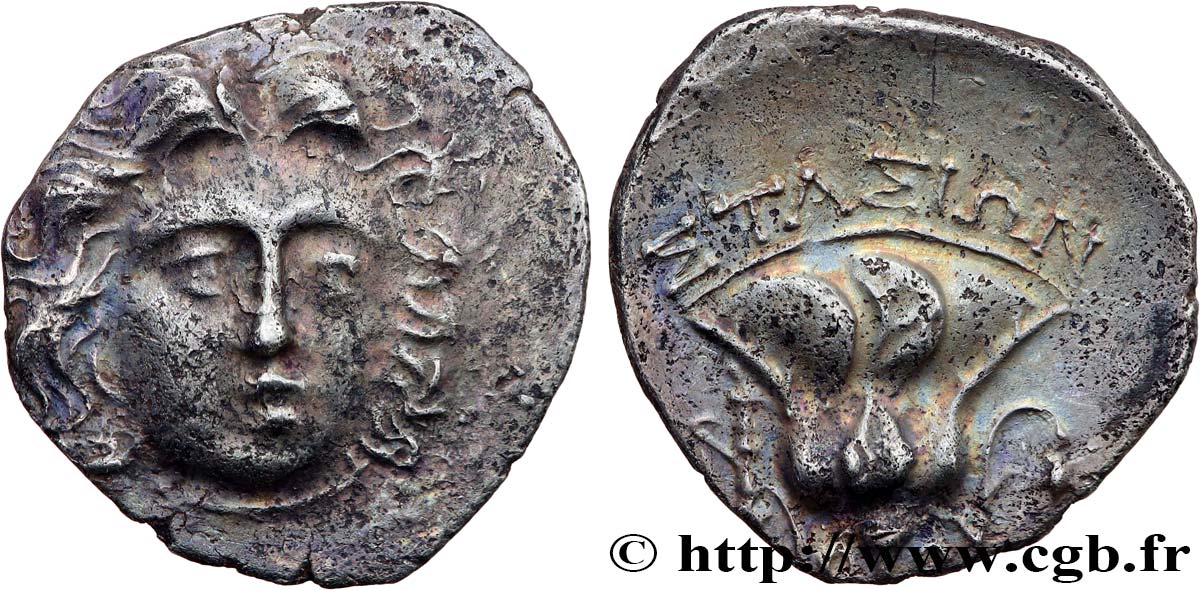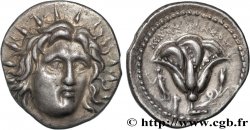bgr_737120 - CARIA - CARIAN ISLANDS - RHODOS Drachme
380.00 €
Количество
Добавить в корзину

Тип Drachme
Дата: c. 205-189 ou 175/170 AC.
Монетный двор / Город: Rhodes
Металл: silver
Диаметр: 16,5 mm
Ориентация осей монеты: 12 h.
Вес: 2,47 g.
Редкость: R2
Комментарии о состоянии
Monnaie sur un flan centré présentant un très joli revers. Patine grise avec de légers reflets dorés et bleutés
Лицевая сторона
Аверс: легенда: ANÉPIGRAPHE.
Аверс: описание: Tête d'Hélios (Apollon) de face à droite, les cheveux tombant.
Обратная сторона
Реверс: Описание: Rose sur sa tige avec un bouton à droite ; dans le champ à gauche, un arc et une massue entrecroisés.
Реверс: легенда: R-O/ STASIWN
Реверс: перевод: (de Rhodes/ Stasion).
Комментарий
L’arc et le carquois sont associés à Stasion qui ne sont représentés que sur des drachmes. Mais le magistrat est aussi associé à un foudre ailé (Ashton 298). R. Ashton nous indique pour ce monétaire : “Die-linking is particularly close among the drachm issues of Gorgos, Peisikrates, Ainetor, Aristakos and Stasion”. Nous retrouvons ce même nom sur des tétradrachmes rhodiens ornés d’une rose au type d’Alexandre III le Grand, datés vers 201-190 avant J.-C. (ECK. 596 = MP. 2517 et coll. E. Karl 526), mais aussi sur des drachmes plinthophores datées entre 188 et 170 avant J.-C. (ECK. 625 = coll. E. Karl 550 avec une étoile dans le champ). Enfin R. Ashton avait mis en lumière des monnaies pseudo-rhodiennes frappées en Grèce Centrale ou du Nord vers 175-170 avant J.-C. (R. H. J. Ashton, NC. 1988, p. 31, n° 34 = ECK. 800 et 801) qui pourrait correspondre tout à fait à notre type monétaire. Ces drachmes auraient été fabriquées afin de stipendier les mercenaires rhodiens qui étaient dans les armées grecques avant la bataille de Pydna.
The bow and quiver are associated with Stasion which are only depicted on drachmas. But the magistrate is also associated with a winged thunderbolt (Ashton 298). R. Ashton tells us for this monetary: “Die-linking is particularly close among the drachm issues of Gorgos, Peisikrates, Ainetor, Aristakos and Stasion”. We find this same name on Rhodian tetradrachms decorated with a rose of the type of Alexander III the Great, dated around 201-190 BC (ECK. 596 = MP. 2517 et coll. E. Karl 526) , but also on plinthophore drachmas dated between 188 and 170 BC (ECK. 625 = coll. E. Karl 550 with a star in the field). Finally R. Ashton had highlighted pseudo-Rhodian coins minted in Central or Northern Greece around 175-170 BC (RHJ Ashton, NC. 1988, p. 31, n° 34 = ECK. 800 and 801) which could correspond entirely to our monetary type. These drachmas would have been made to pay for the Rhodian mercenaries who were in the Greek armies before the battle of Pydna
The bow and quiver are associated with Stasion which are only depicted on drachmas. But the magistrate is also associated with a winged thunderbolt (Ashton 298). R. Ashton tells us for this monetary: “Die-linking is particularly close among the drachm issues of Gorgos, Peisikrates, Ainetor, Aristakos and Stasion”. We find this same name on Rhodian tetradrachms decorated with a rose of the type of Alexander III the Great, dated around 201-190 BC (ECK. 596 = MP. 2517 et coll. E. Karl 526) , but also on plinthophore drachmas dated between 188 and 170 BC (ECK. 625 = coll. E. Karl 550 with a star in the field). Finally R. Ashton had highlighted pseudo-Rhodian coins minted in Central or Northern Greece around 175-170 BC (RHJ Ashton, NC. 1988, p. 31, n° 34 = ECK. 800 and 801) which could correspond entirely to our monetary type. These drachmas would have been made to pay for the Rhodian mercenaries who were in the Greek armies before the battle of Pydna








 Cообщить об ошибке
Cообщить об ошибке Распечатать страницу
Распечатать страницу Отправить мой выбор
Отправить мой выбор Задать вопрос
Задать вопрос Consign / sell
Consign / sell
 Информация
Информация










